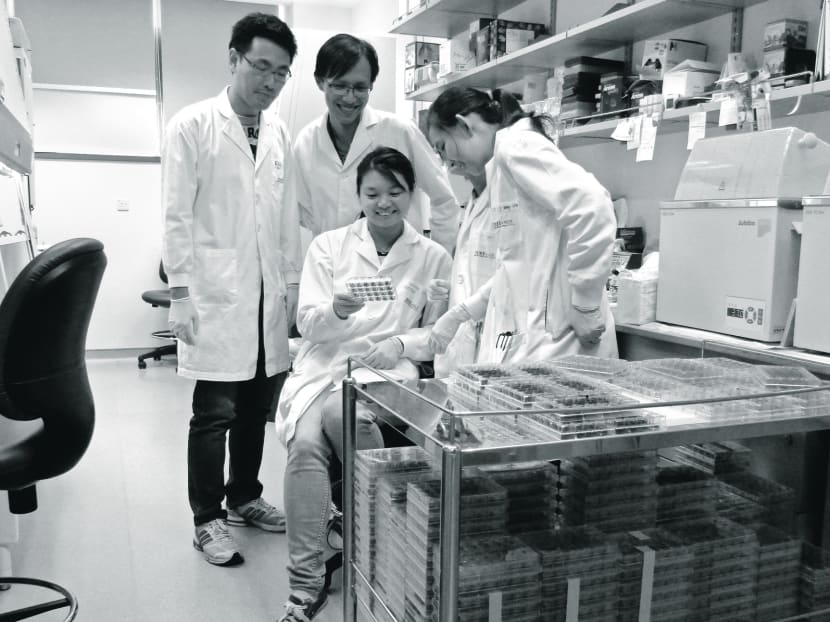Chasing that elusive dengue vaccine
The scourge of dengue extends throughout the tropical world and now encroaches on subtropical areas, even as in Singapore last week, the number of cases (492) hit a high for this year.

Researchers from Assoc Prof Ooi Eng Eong’s lab studying a dengue virus sample. Photo: Duke-NUS Graduate Medical School
The scourge of dengue extends throughout the tropical world and now encroaches on subtropical areas, even as in Singapore last week, the number of cases (492) hit a high for this year.
A recent study estimated that nearly 400 million people are infected each year; another three billion are at risk of infection. Yet, there is neither a vaccine that can prevent infection nor a specific antiviral drug for a severe case of the disease.
The lack of an effective vaccine is not for want of effort. Interestingly, the call for a global effort to develop a dengue vaccine was made here in Singapore in 1977.
That meeting, organised by what was then the University of Singapore and supported by the World Health Organization (WHO), brought together world leaders in dengue research to identify a strategy for dengue vaccine development. The meeting concluded that, if all went well, the world would have a dengue vaccine for use in 10 years. It has now been 36 years since that meeting and we still do not have a dengue vaccine. Obviously, all did not go well.
Why has dengue vaccine development been so difficult?
NOT TOO WEAK,NOT TOO STRONG
Early studies have shown that a vaccine composed of weakened dengue viruses offers the best hope of protection. However, over the course of vaccine development, we learnt that an insufficiently weakened virus would still cause dengue fever, while an over-weakened virus would not generate useful immune response.
Deriving a virus that is sufficiently weakened not to cause disease but not too weakened to be useless as a vaccine has been challenging.
Vaccine development received a major boost when genetic tools became available. Instead of relying on chance to derive a suitably weakened virus, genetic tools have enabled us to construct chimeric vaccines that meet all the criteria of safety and immunogenicity — the ability to provoke an immune response. The current leading dengue vaccine candidates are all products of such genetic tools.
Another major hurdle vaccine development faces is the complexity of dengue. There are four different types of dengue virus. Within each of these types, not only are there genetic variations that contribute to the diversity of the virus, but some of these mutations also give rise to fitter viruses that are more able to cause outbreaks.
Furthermore, the immune response that one develops following infection with one of the four dengue viruses, appears to enhance disease when we have a second infection with any of the remaining three viruses.
The challenge, thus, is to develop a vaccine that is able to protect against the diversity of dengue virus without generating an immune response that might enhance disease instead.
That is a tall order.
SINGAPORE’S CONTRIBUTION
The need for research that unravels the complexity of the molecular mechanisms that lead to illness is thus all the more urgent. How then is Singapore contributing to this global effort in vaccine development?
Ironically, while the original call for a global effort in dengue vaccine development was made here, there had been little impetus for Singapore to develop a dengue vaccine since then.
In 1970, Singapore launched a control programme targeted at reducing the Aedes aegypti mosquito population. After some teething problems, we enjoyed a 15-year period of low dengue incidence from 1975 on. Hence, in 1977, it would have appeared as if dengue would follow the same fate as malaria — Singapore was declared malaria-free by the WHO in 1981.
Hence, for decades after 1977, there was only one virologist in Singapore working on solving dengue.
Today, dengue research is very much a multi-disciplinary and collaborative effort. In 2003, Drs Subhash Vasudevan, Martin Hibberd and I started a consortium that brings together clinicians and researchers to achieve a critical mass to accelerate dengue research.
That small group has since grown and the dengue research community in Singapore now comprises infectious disease specialists, virologists, immunologists, epidemiologists, entomologists, genetic and protein engineers from the Duke-NUS Graduate Medical School; the National University of Singapore; Nanyang Technological University; the research institutes at A*STAR such as the Genome Institute of Singapore, Singapore Immunology Network and Experimental Therapeutics Centre; the Singapore General Hospital, Tan Tock Seng Hospital and National University Health System; the Environmental Health Institute; DSO National Laboratories; Novartis Institute for Tropical Diseases, and the Infectious Disease Interdisciplinary Research Group of the Singapore-MIT Alliance for Research and Technology.
The complexity of dengue cannot be solved by a single person with limited skills. It demands a team effort. The collaborative effort locally will also need to be harnessed and coordinated with international efforts.
Singapore’s investment is beginning to bear fruit.
Two monoclonal antibodies have been developed in Singapore that could potentially be used to treat dengue patients.
A clinical trial on a drug against dengue has been completed and is in the analysis phase — this is only the third clinical trial in the world for a drug against dengue.
Improved diagnostic and triaging strategies have reduced the percentage of hospitalisation for dengue patients. These results are emerging as we improve our understanding of the biology of disease and immunity. The long history of dengue vaccine development tells us that there is no short cut to this process.
Meanwhile, for those of us working on solving dengue, 400 million people each year await our efforts.
ABOUT THE AUTHOR:
Associate Professor Ooi Eng Eong is Deputy Director of the Program in Emerging Infectious Diseases at the Duke-NUS Graduate Medical School.






